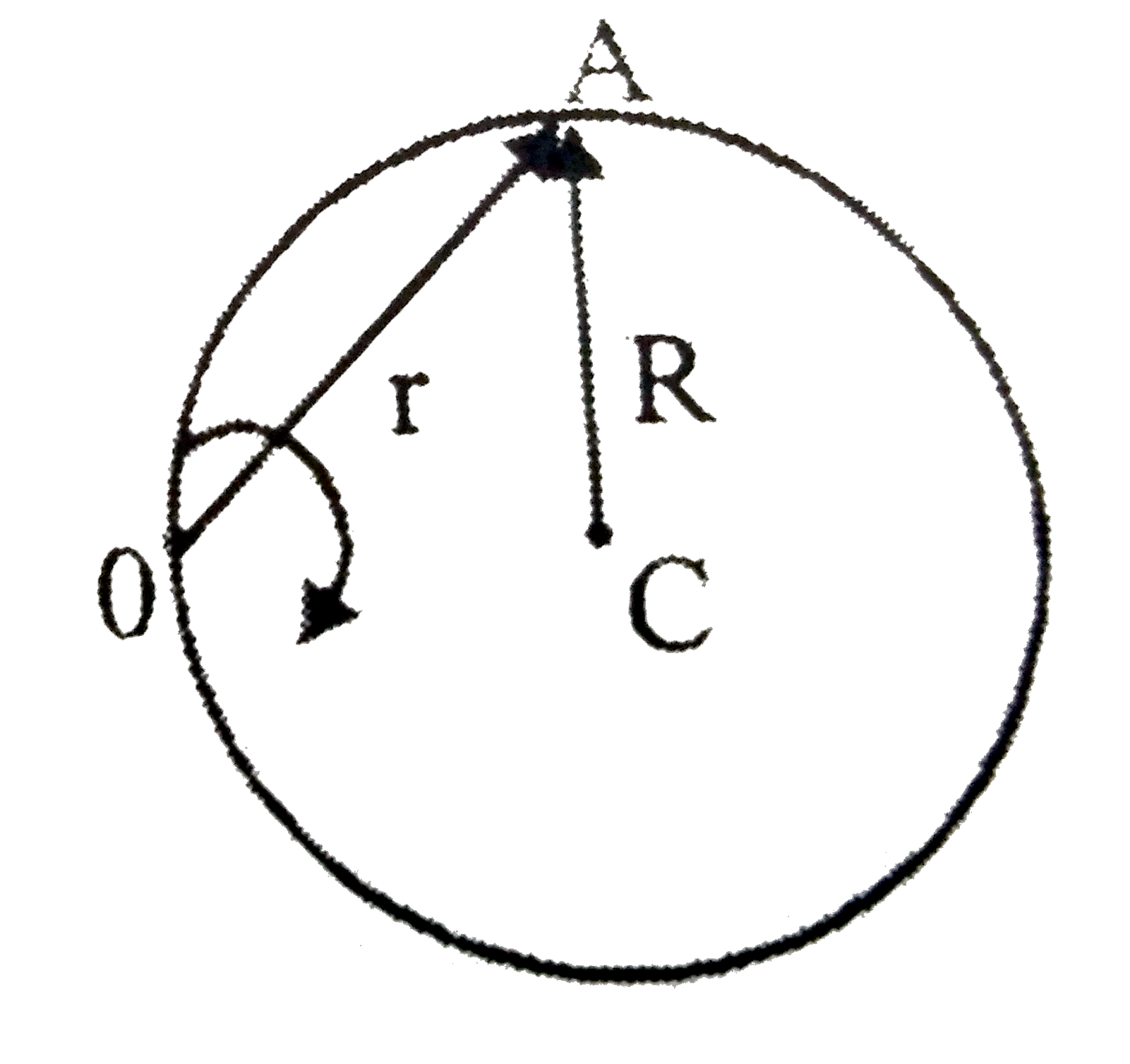A particle A moves along a circle of radius R=50 cm so that its radius vector r relative to the point O (figure) rotates with the constant angular velocity ω=0.40rad/s. Then modulus of the velocity of the particle, and the modulus of its total acceleration will be
 Solution in Gujrati
Solution in Gujrati
v=0.4m/s,a=0.4m/s2
v=0.32m/s,a=0.32m/s2
v=0.32m/s,a=0.4m/s2
v=0.4m/s,a=0.32m/s2
The correct Answer is:D
Angular velocity ω about centre =2ω
=2×0.40=0.30rad/sec
v=ωR
=0.80×12=0.40m/s
a=v2R=0.40×0.40×10050=0.32cm/s2
Topper's Solved these Questions
- KINEMATICSBook:ALLEN Chapter:KINEMATICSExercise:EXERCISE-02
Explore 57 Videos
- KINEMATICSBook:ALLEN Chapter:KINEMATICSExercise:EXERCISE-03
Explore 6 Videos
- KINEMATICSBook:ALLEN Chapter:KINEMATICSExercise:EXERCISE-2
Explore 89 Videos
- ERROR AND MEASUREMENTBook:ALLEN Chapter:ERROR AND MEASUREMENTExercise:Part-2(Exercise-2)(B)
Explore 22 Videos
- KINEMATICS (MOTION ALONG A STRAIGHT LINE AND MOTION IN A PLANE)Book:ALLEN Chapter:KINEMATICS (MOTION ALONG A STRAIGHT LINE AND MOTION IN A PLANE)Exercise:BEGINNER S BOX-7
Explore 8 Videos
Similar Questions
A particle is moving in a plane with velocity given by →u=u0ˆi+(aωcosωt)ˆj, where ˆi and ˆj are unit vectors along x and y axes respectively. If particle is at the origin at t=0. Calculate the trajectory of the particle :-
View SolutionThe equation of one dimensional motion of the particle is described in column I. At t=0, particle is at origin and at rest. Match the column I with the statement in Column II.
Column IColumn II(A)x=(3t2+2)m(p)Velocity of particle at t=1s is 8m/s(B)v=8tm/s(q)Particle moves with uniform acceleration(C)a=16t(r)Particle moves with variable acceleration(D)v=6t−3t2(s)Particle will change its direction some time
View SolutionA student performs an experiment to determine how the range of a ball depends on the velocity with which it is projected. The "range" is the distance between the points where the ball lends and from where it was projected, assuming it lands at the same height from which it was projected. It each trial, the student uses the same baseball, and launches it at the same angle. Table shows the experimental results.
∣∣ ∣ ∣ ∣ ∣ ∣∣TrailLaunch speed(m/s)Range(m)110822031.833070.7440122.5∣∣ ∣ ∣ ∣ ∣ ∣∣
Based on this data, the student then hypothesizes that the range, R, depends on the initial speed v0 according to the following equation : R=Cvn0, where C is a constant and n is another constant.
Based on this data, the best guess for the value of n is :-
View SolutionA cube has a side of length 1.2×10−2m. Calculate its volume.
View SolutionA football player kicks a ball at an angle of 30∘ with an initial speed of 20 m/s. Assuming that the ball travels in a vertical plane, calculate (a) the time at which the ball reaches the highest point (b) the maximum height reached (c) the horizontal range of the ball (d) the time for which the ball is in the air, (g=10m/s2)
View SolutionA particle moves along a circle of radius R =1m so that its radius vector vecr relative to a point on its circumference rotates with the constant angular velocity omega=2rad//s . The linear speed of the particle is
View SolutionA particle A moves along a circle of radius R=50cm so that its radius vector r relative to the point O(figure) rotates with the constant angular velocity omega=0.40rad//s . Find the modulus of the velocity of the particle, and the modulus and direction of its total acceleration.
View SolutionA particle moves along a circle of radius R with a constant angular speed omega . Its displacement (only magnitude) in time t will be
View SolutionA particle moves along a circle of radius R with a constant angular speed omega . Its displacement (only magnitude) in time t will be
View SolutionA particle 'A' moves along a circle of radius R = 50 cm, so that its radius vetor 'r' relative to the point O rotates with the constant angular velocity ω=0.4rad/s. Then :
View SolutionThe linear velocity perpendicular to radius vector of a particle moving with angular velocity omega=2hatK at position vector r=2hati+2hatj is
View SolutionA particle moves in a circle of radius r with angular velocity omega . At some instant its velocity is v radius vector with respect to centre of the circel is r.At this particular instant centripetal acceleration a_(c) of the particle would be
View SolutionLet r be the radius vector of a particle in motion about some reference point and r its modulus. Similarly, v be the velocity vector and v its modulus. Then
View SolutionA circular disc of radius R is rotating about its axis O with a uniform angular velocity omega"rad s"^(-1) as shown in the figure. The magnitude of the relative velocity of point A relative to point B on the disc is
View SolutionA particle moving along a circule path of radius 'r' with uniform angular velocity omega . Its angular acceleration is
View SolutionA particle is moving in a circle of radius r with constant angular velocity omega . At any point (r, theta ) on its path , its position vector is vec(r ) = r cos theta hat(i) + r sin theta hat(j) . Show that the velocity of the particle has no component along the radius.
View Solution
